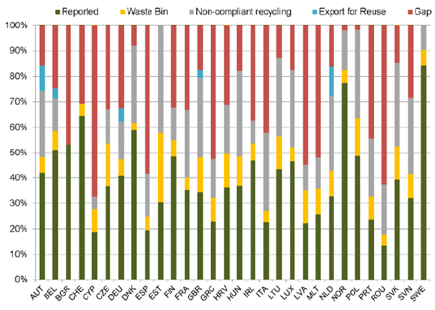
We produce around 10 million tonnes of WEEE per year in the EU. A meagre 35% of electrical and electronic equipment, both used and disposed of as waste, discarded by companies and consumers in 2012, wound up in official collection and recycling systems.
The other discarded electronics were either recycled under non-compliant conditions, illegally traded, exported, or simply  thrown in residual waste bins. Even in the few EU member states with robust, effective reporting systems, monitoring of de-pollution efforts and up-to-standard treatment conditions are not always securely in place.
thrown in residual waste bins. Even in the few EU member states with robust, effective reporting systems, monitoring of de-pollution efforts and up-to-standard treatment conditions are not always securely in place.
WEEE contains many high value and critical raw materials. In addition to the loss of these valuable materials, significant financial losses result from discarding them. It is estimated that overall potential revenues from WEEE recycling in the EU could amount to € 2.15-3.67 billion by 2020.
Good practices
Better guidelines and formal definitions are required to help authorities distinguish between used, non-waste electrical and electronic equipment, and actual waste (WEEE). A report of the Swedish EPA shows that the amount of collected WEEE per inhabitant has increased substantially since 2002, arguably caused by the cooperation between municipalities and producers, recycling centres and also the Swedish waste culture with households’ high awareness of waste sorting.
Examples of identified actions that municipalities or regional authorities can take on are investing in security at collection points (e.g. CCTV), contributing to awareness-raising campaigns or collection initiatives, or taking part in ‘local monitoring’.